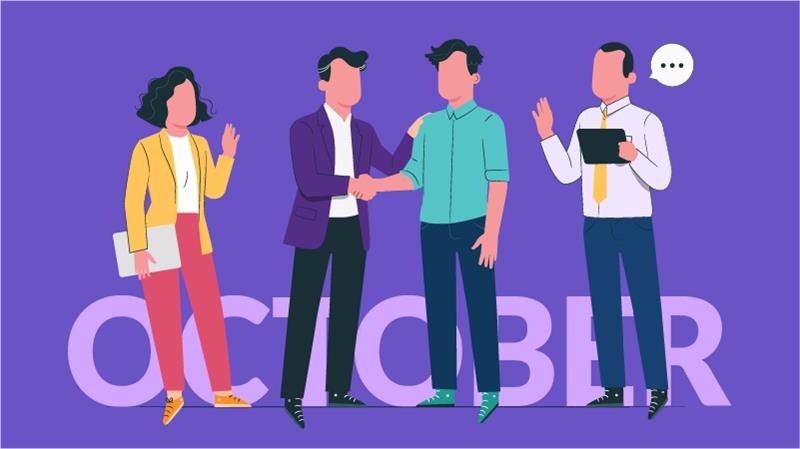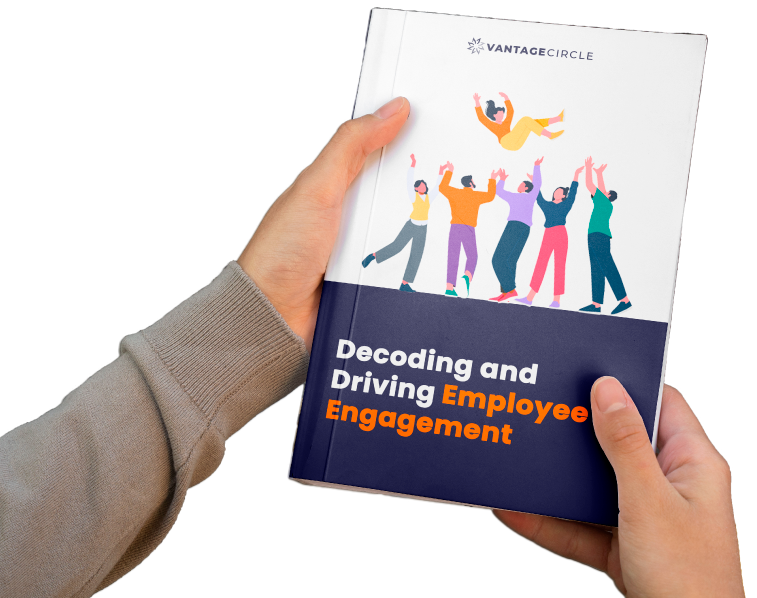Retail Employee Engagement: Strategies, Solutions & Ideas to Motivate Your Frontline Workforce

A Global Employee Recognition and Wellness Platform
During my brief stint as a retailer, I learned that the energy of the store came from the team on the floor. A motivated and engaged workforce made all the difference in delivering an exceptional customer experience.
But here’s the thing that employee engagement isn’t just about offering perks or throwing a party. It's about building a culture where employees feel genuinely valued, empowered, and connected to the company’s mission.
And retail employee engagement is no exception; it is a game-changer for businesses. When employees are engaged, they become loyal, productive, and willingly go beyond their roles.
And the interesting news? Retail businesses can also implement simple yet effective strategies to motivate their teams.
In this blog, I’ll walk you through proven ideas, strategies, and tools that you can implement right away to boost your team engagement. Let’s explore how you can turn your frontline workforce into your greatest asset.
Why Employee Engagement is Critical in Retail

The foundation of retail success is our frontline workforce. So, in this industry where frontline workers heavily influence customer experience, brand perception, and sales, employee engagement is non-negotiable.
Engaged employees not only bring enthusiasm and commitment but also enhance customer satisfaction and foster loyalty.
Here’s why Employee Engagement is Critical in Retail:
1. Reduces High Turnover Costs
A McKinsey study discovered that the turnover rate in the retail industry is 70% higher than in other industries.
Compared to other industries, retail experiences the highest employee turnover rates. Consequently, the increase in hirings and training drains resources and disrupts store operations.
However, engaged employees paint a different picture. They are inclined to stay and commit to the organization, ultimately saving significant time and money.
2. Boosts Productivity and Sales
Research by Gallup has demonstrated that engaged employees make 18% more sales and 23% higher profitability.
Engaged retail employees demonstrate heightened productivity by serving customers more efficiently, solving problems proactively, and selling more. Higher engagement translates into better store performance and increased profits.
3. Improves Customer Service and Loyalty
We all know that happy employees create happy customers. This happiness stems from feeling valued and engaged, making them go the extra mile for customers.
They do not simply process transactions but create experiences for customers. They take ownership of problems, offer solutions proactively, encourage repeat visits, and represent our brands with genuine enthusiasm. As a result, it gives your store a competitive edge.
Gallup study finds that highly engaged employees achieve 10% higher customer loyalty/engagement
4. Reduces Absenteeism and Mistakes
Disengaged employees are frequently absent and prone to making errors, all of which adds to the cost and negatively impacts the customer experience.
On the other hand, engaged teams willingly show up, pay close attention, and demonstrate a genuine care about getting things right and resolving mistakes.
5. Prevents Burnout and Supports Well-being
According to Grant Thornton research, 55% of retail employees have suffered burnout, with mental health issues and worker shortages cited as the top causes.
The concerning factor is that 41% of retail workers cite "unrealistic expectations" as a significant stressor.
The figures shed light on how the industry creates unsustainable working conditions, which worsen their mental health, and drive talented people away from retail careers.
The psychological toll of burnout results in fatigue, irritability, reduced job performance, and disconnection from work.
However, workplaces that support mental well-being help employees keep their burnout at bay, keeping them healthier and more resilient.
6. Drives Operational Excellence
Research reveals that companies with high employee engagement levels experience annual earnings per share growth of 4.6%, compared to a decline of 0.4% in organizations with low engagement levels.
Strong engagement contributes to more streamlined operations. There is less waste, fewer out-of-stocks, lower labor costs, and lower rates of internal theft and shrinkage.
When employees feel connected to their work and valued by their organization, they become protectors of the business rather than sources of loss. All these add up to stronger store financials.
Unique Challenges to Employee Engagement in Retail
Like every industry has some set of challenges that are particular to it, similarly, the retail sector faces unique challenges while ensuring employee engagement.
Let us dive into them:
1. High Turnover: The Never-Ending Hiring Loop
As mentioned earlier, retail turnover is alarmingly high and incurs a significant cost to businesses, with replacement costs varying depending on the positions.
The consequences are not limited to financial crunch; it also affects store morale, customer experience, and knowledge retention.
Several factors contribute to the high turnover rate in retail. Limited career growth opportunities, wage compression, schedule instability, burnout, and safety concerns are the primary factors.
2. Scheduling Chaos: The Pain of Unpredictable Shifts
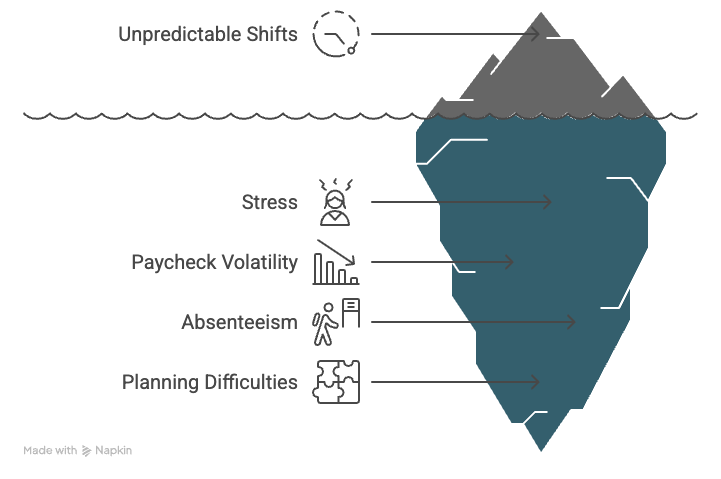
Retail employees frequently face unpredictable schedules, with many receiving less than two weeks’ notice for their shifts.
In some cases, workers even experience “clopening”, where the store closes late at night and opens early the next morning.
Such unpredictability leads to stress, paycheck volatility, and absenteeism. It also hinders their planning for other events such as studies and childcare.
3. Health & Performance Consequences
Unstable and unpredictable schedules come with a cost to health. Workers are likely to suffer from sleep deficits and hunger, thus increasing absenteeism and lowering engagement.
How can you expect employees to be engaged while their health is at stake due to irregular work hours?
This emphasizes the vital connection between employee well-being and workplace performance. When employees have more predictable schedules, their health improves, which in turn drives better results for the business.
Research conducted in Gap Inc.stores found that implementing responsible scheduling practices led to a 5.1% increase in productivity and a 3.3% boost in sales while reducing labor hours by 1.8%.
4. Emotional Labor: The Hidden Cost of “Smile-As-Standard”
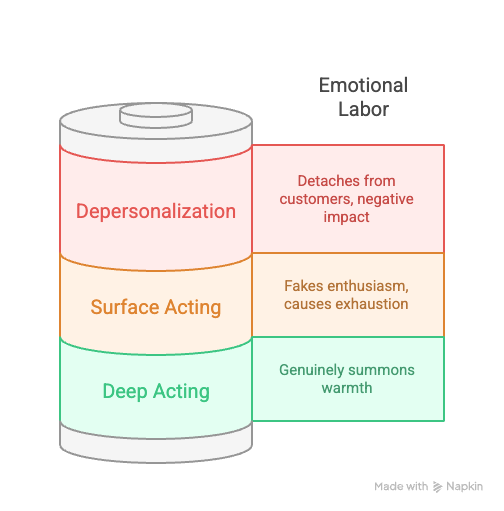
Retail workers are required to “surface act” (fake enthusiasm) or “deep act” (genuinely summon warmth) innumerable times per shift. Surface acting can take a toll on employees, causing emotional exhaustion and job stress.
Additionally, this form of emotional labor intensifies emotional strain and makes workers aggressive and violent, thus leading to customer misbehavior.
Research shows:
- Retail scored in the bottom 10% for workplace mental health.
- 84% of retail workers report declining mental health in recent years.
This is how burnout sets in. Initially, employees experience emotional exhaustion, characterized by feelings of tiredness.
This is followed by depersonalization, where employees detach from customers, negatively impacting the customer experience. This leads to the final stage, reduced accomplishment, where employees lose their productivity, creativity, and problem-solving abilities.
5. Dual Pressures: Internal vs. External Stressors
Retail employees are subjected to stress from both internal and external sources.
Internal pressures include staffing shortages and lean staffing, which make it harder to maintain security and manage inventory. Technology overload becomes stressful when associates are tasked with troubleshooting self-checkouts and managing endless app processes.
Externally, employees increasingly face aggression and violence from customers. These pressures disengage employees and compel them to leave.
According to research, the retail industry has a higher number (41%) of employees who feel overwhelmed and excessively pressured at work compared to all other sectors combined (29%).
What Retail Employees Actually Need to Feel Engaged
We are now well aware of the challenges haunting retail employees. It’s high time that we understood what can truly get them engaged.
Let’s eliminate assumptions and focus on what they truly need.
1. Competitive Pay
Hourly pay varies in the retail sector. For instance, general merchandise clerks earn between $12–$13 per hour, while auto sales reps can make up to $21 per hour.
This pay gap is a concern and one of the major drivers of turnover. Therefore, flexible pay or earned wage access is becoming a necessity. Retailers who have been offering these options have reported reduced financial stress and an increase in employee engagement.
2. Benefits They Can Use
Benefits are key to retaining your employees. However, benefits must be planned accordingly to cater to the differing needs of generations.
Boomers prioritize stable medical plans, and Millennials focus on family benefits and flexible PTO. Likewise, Genz seeks mental health coverage and tuition support.
3. A Workplace That Feels Safe
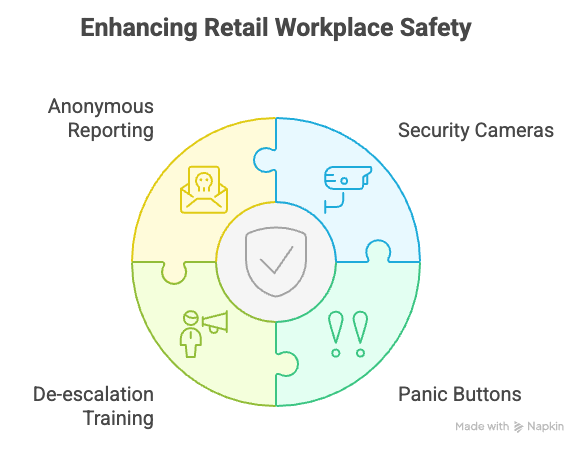
Safety is a fundamental right applicable to any workplace. However, retail employees are still struggling with safety.
A survey reveals that 80% of retail workers are scared every day as they clock in for work, and 72% have experienced incidents.
To address this and ensure safety for employees, introduce visible deterrents like security cameras and panic buttons, along with de-escalation training.
The provision of clear, anonymous incident reporting is also a must for many younger workers.
4. Employee Wellness
Introducing comprehensive wellness programs can help maintain employees’ well-being in check.
This includes offering on-demand mental health support through apps, flexible wellness hours during shifts, and stress-relief programs like yoga and meditation.
Providing health and fitness incentives, such as wellness challenges, gym memberships, along with nutritious snack options and ergonomic workstations, can keep employees physically and mentally energized.
However, employees’ participation remains low, primarily due to inconvenient hours or locations. Offering on-demand apps, short micro-sessions during paid time, and incentives that employees truly value, like cash or schedule flexibility, can help improve participation.
5. Predictable Schedules and Adequate Hours
One of the major issues troubling retail workers is the unpredictable schedules. But when you plan shifts accordingly by avoiding last-minute changes, things can drastically change.
Scheduling shifts at least 14 days in advance can be a simple yet effective way to reduce absenteeism and turnover costs.
6. Frequent, Genuine Recognition
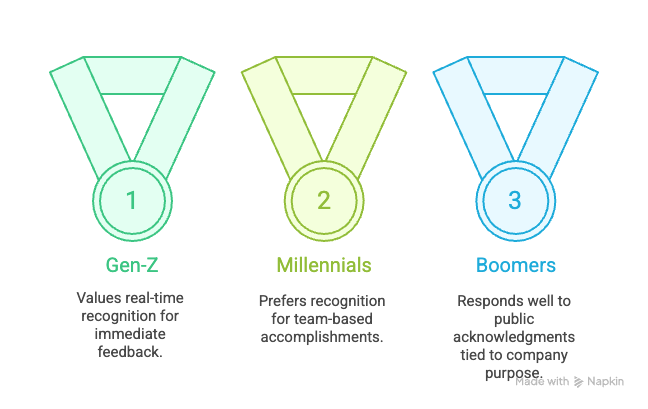
Regular and genuine recognition is what keeps employees motivated and gives them a purpose to work hard for.
Recognition is key to keeping employees engaged, and they are likely to stay in the organization in the long run. A Gallup research found that well-recognized employees are 45% less likely to change organizations after two years.
Consider generational preferences while recognizing. Gen-Z values real-time recognition, whereas millennials prefer recognition for team-based accomplishments. Boomers, on the other hand, respond well to public acknowledgments that tie their work to the company’s overall purpose.
7. Visible Paths for Growth
Lack of career advancement is a leading cause of employee turnover.
A McKinsey study shows that 32% of respondents consider leaving their jobs in the next couple of months due to inadequate career growth opportunities.
To address this issue, you can take the necessary measures and support your employees' career development.
Offer micro-promotions with skills badges and a pay raise. Additionally, cross-training opportunities help keep job roles fresh and interesting, catering to both Boomers’ desire for variety and Gen Z’s hunger for learning.
Regular one-on-one meetings for career progression will give employees a clear picture of where they are headed in their careers, which will keep them motivated throughout.
Effective Retail Employee Engagement Strategies
Here are some effective ways to boost employee engagement in retail stores:
1. Clear and Open Communication
Employee engagement is incomplete without improved and effective communication. Two-way communication channels are a must to make employees feel informed and valued, ensuring transparency.
To establish strong communication, consider implementing regular team meetings, utilizing digital communication tools (such as apps or intranets), and establishing feedback loops.
Leadership, especially CEOs, should actively engage with employees through regular CEO messages or store visits to reinforce transparency and trust.
2. Consistent and Meaningful Recognition
Recognizing your employees’ efforts can make a huge difference in engaging them.
Regular shout-outs from managers, company-wide awards, or personalized messages from leaders can work wonders in keeping employees thoroughly motivated.
Also, conferring them with spot awards, instantly recognizes their accomplishments, boosting their morale.

Source: Vantage Recognition
Moving forward, I recommend implementing phygital recognition, which blends both physical and digital modes of recognition and rewards.
Given the retail setting where many workers often lack access to digital platforms, this form of recognition proves to be a savior. Such a token of appreciation ensures that field workers and those working behind the scenes receive the acknowledgment they deserve.
As a result, it bridges the gap between those who are frequently recognized and those who often go unnoticed.

3. Career Development and Growth
Every employee seeks to grow and develop in their respective fields, and retail employees are no exception.
Offering opportunities for skill development, micro-promotions, and cross-training can increase engagement and loyalty.
Regular one-on-ones between employees and managers to discuss career progression and goals are key.
You can also offer them educational benefits or access to learning platforms that will help build their abilities and make them future-ready.
4. Wellness Initiatives
Given the physical and mental demands of retail work, employees get easily drained. Therefore, ensuring their wellness is key to keeping them engaged.
On-demand health programs, fitness incentives, and mental health support help reduce burnout and absenteeism.
Leadership must also prioritize wellness that makes employees feel supported, which in turn enhances their engagement and performance.
Therefore, opting for employee wellness platforms like Vantage Fit can help leaders strengthen the employees’ well-being and maintain a healthy workforce with its unique initiatives.
5. Flexibility and Work-Life Balance
As discussed earlier, retail employees often struggle with unpredictable schedules and work-life balance. The key is to provide them the necessary flexibility at work that will encourage them to work willingly.
Flexible scheduling options, such as predictable shifts, work-from-home opportunities for corporate functions, or earned wage access, can significantly improve job satisfaction.
Creating an environment that supports flexibility, whether through shift-swapping, mobile scheduling apps, or setting boundaries for overtime, is the best way to encourage better work-life integration and boost retention.
6. Leadership Visibility and Engagement
Leadership visibility and support are essential for fostering an engaged workforce. All the strategies discussed above can only be effectively implemented and succeed when leaders proactively drive them forward.
This can include store visits, town halls, and regular communication such as CEO messages that highlight company successes and future goals.
When employees witness leadership actively involved and invested in their daily work experience, it boosts morale and strengthens the connection between top-level strategies and day-to-day operations.
Leaders should also encourage open forums for feedback, where employees can voice their concerns and suggestions, reinforcing a culture of inclusion and engagement.
Real-World Examples from Leading Retailers
While retailers have their fair share of struggles while trying to engage their employees, there are some concrete case studies of leading retailers that you can learn a lot from.
Walmart
Walmart stands out as a leader in retail not only for its business scale but also for its commitment to employee engagement.
In 2024, Walmart raised employee wages again, with the average frontline worker earning $18 an hour and store managers making between $90,000 to $170,000 annually, up from a starting salary of $65,000.
Walmart provides financial tools like a 401(k) and an associate stock purchase program, along with training resources through its digital app, Me@Walmart.
These investments have had a significant impact on employee satisfaction. According to Walmart's Trust Index™ Survey, the number of hourly workers reporting fair pay increased by 61% from 2017 to 2023, and those saying they receive a fair share of company profits rose by 70%.
Walmart employees also receive training and development support than their counterparts at other retail companies. While only 53% of retail workers report receiving career development opportunities, at Walmart, two-thirds of retail employees say they receive training and support to advance their careers.
Starbucks
Starbucks is another grand retailer that has not only expanded its reach globally but has managed to engage its employees.
Starbucks’ employee focus is a vital part of its culture. This has contributed to Starbucks’ increased shares to almost 20%.
By prioritizing employees, Starbucks has created an environment that encourages well-being and professional growth. It has enhanced its scheduling systems to provide more consistent shifts, improving the working conditions.
The company’s approach to retaining green-aproned workers has been supported by the offering of a much-improved parental leave policy for new parents.
Retail Engagement Ideas You Can Start This Week
Small retailers can also energize and engage their teams without having to burn a hole in their pockets.
Here are some budget-friendly ideas that are powerful enough to increase morale, productivity, and retention.
1. Handwritten Thank-You Notes in Lockers
I believe nothing can beat the essence of personal recognition. Leaving a handwritten note on a card at every associate’s locker leaves a lasting smile on the employees after a day’s busy schedule. Mention a specific behavior that you noticed. This costs pennies.
2. Two-Minute Shift Huddles with a Twist
Start every shift with a quick 2-minute huddle. Share a success story, highlight the sales focus for the day, and do a short stretch to energize the team. Use a timer to stick to the 2-minute limit and respect everyone’s time.
3. “Spin-the-Wheel” Sales Game
Print a DIY prize wheel on posterboard by slicing it into eight wedges. Include prizes like free coffee, a fifteen-minute early exit, and the opportunity to choose tomorrow’s playlist, etc., and mount them near the POS.
When someone hits a day’s target, they get the chance to spin. Friendly competition boosts sales and adds an essence of fun.
4. Flexible “Shift-Swap Self-Serve” Binder
Place a clipboard in the break room that allows employees to list shifts they wish to swap or pick up. Self-service scheduling boosts morale and reduces absenteeism. Make sure to approve swaps the same day to strengthen trust.
5. “Quiet Corner” Wellness Box
Transform a small space into a quiet area with a folding chair, stress balls, and a deep-breathing guide. Allow employees to take 5-minute paid breaks during long shifts. These short wellness breaks bring down stress levels and enhance overall service quality.
6. “Failure of the Week” Story
Normalize learning by asking a volunteer to share a misstep at the Friday closing and how they fixed it. Celebrate the lesson, not the error, as it lightens perfection pressure and strengthens team trust.
7. “Badge Blitz” Skill Badging
Print DIY skill stickers such as “POS Ninja,” “Folding Pro,” “Stockroom Ace,” etc. When someone masters a task, give them the badge for their name tag.
8. Ten-Question Pulse Survey
Create a free Google Form to assess how secure, heard, and energized employees feel in a particular week. Share one data-driven action the same day results close. Frequent feedback loops will make staff believe that leadership cares.
9. “Volunteer Hour” Swap
Trade one hour of Sunday floor time for a neighborhood clean-up or food-bank stint. Paid volunteer time off is among the top three benefits boosting frontline engagement, even at small companies.
Retail Engagement Technology & Tools
To make your retail culture a thriving one, you must make use of the right technology.
Let’s take a glance at the tools that can make a difference in engaging retail employees and how they can be integrated into your existing systems.
Why the Right Tech Stack Matters
Modern engagement software is designed to reduce daily task friction, amplify employee voice, and provide leadership with real-time analytics.
When integrated with payroll and scheduling systems, it eliminates data silos and guarantees smooth communication.
Recognition and Rewarding Platform
Platforms like Vantage Recognition can make your recognition and rewarding process swift and hassle-free.
This platform can help build a recognition culture by practicing real-time recognition regularly.
Additionally, its integration with HR systems enables HRs to track the implementation of recognition and showcase insights about its usage and the necessary challenges that need to be addressed.
Mobile Employee Apps
Apps like Beekeeper and Blink offer features that frontline workers need, all in one platform, including shift swaps, payslips, and recognition.
These apps perfectly sync with scheduling software that ensures employees receive updated shift information.
Axonify provides bite-sized training that automatically integrates with payroll and scheduling tools to enhance employee skills and compliance.
Modern Intranets
Unlike traditional intranets, apps like Blink make information more accessible to employees by enabling them to pin important documents to an easy-to-search hub.
Its seamless integration with payroll and scheduling ensures that updates like name changes reflect across all platforms automatically.
Email and Digest Tools
Apps like Beekeeper and Blink convert emails into push notifications or in-app alerts, which allows employees to see important messages at the right time.
Tools like Constant Contact and Mailchimp assist in automating communications based on employee data, such as onboarding or regional promotions.
Survey and Feedback Platforms
Tools like Vantage Pulse facilitate the collection of real-time feedback through pulse surveys.
Its seamless integration with HR systems ensures data accuracy and automatic segmentation by location, role, or other demographics, making it easier to track engagement and performance.
Payroll and Scheduling Integrations
When systems like ADP, Deputy, and Blink work together, they streamline processes. For example, employees can see their shift details and earnings directly in the app, reducing confusion about pay. This integration builds transparency, increases trust, and boosts engagement.
Future-Proofing Your Tech
Look for tools that are AI-compatible and can accordingly scale with your needs. For example, Blink’s AI Assist automatically translates communications into multiple languages. Make sure the technology you choose will keep up with your evolving systems.
Conclusion
As we wrap up our discussion, you are probably clear now that engaging retail employees is an ongoing process that keeps evolving with your business, customers, and workforce. It’s not a one-time project but a continuous practice that requires your daily attention, quick diagnosis of pain points, and constant improvement.
FAQs
What is retail employee engagement?
Retail employee engagement refers to the level of enthusiasm and commitment retail employees have toward their work, their team, and the organization. Engaged employees are motivated, productive, and provide excellent customer service.
Why do retail employees disengage quickly?
Retail employees often disengage due to low pay, lack of career growth, monotonous work, poor management, and feeling undervalued or disconnected from the company’s goals.
What are the most effective strategies to boost retail employee engagement today?
Effective strategies include providing regular recognition, offering growth opportunities, fostering a positive work culture, encouraging open communication, and ensuring employees feel valued and supported.
How do you motivate retail employees without money?
Motivating retail employees without money can be achieved through non-monetary rewards like public recognition, offering flexible schedules, providing learning opportunities, and creating a supportive and inclusive work environment.












